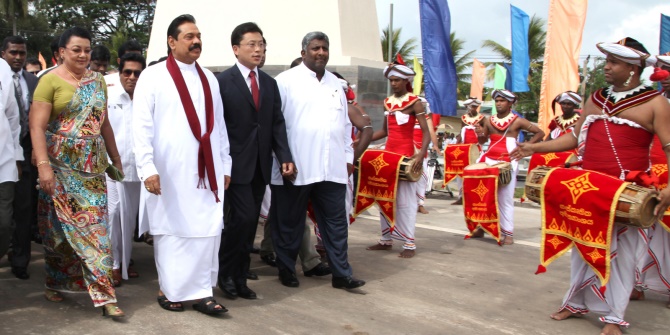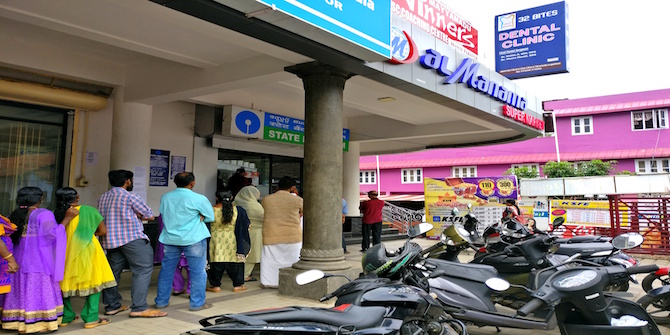Kazuo Kobayashi explains how the demand for Indian cotton textiles among Africans underpinned the trans-Atlantic slave trade in the eighteenth century. Click here for more articles in the ‘Why India-Africa relations matter’ blog series.
The eighteenth century saw the rapid development of the Atlantic economy, which was characterised by slavery-based plantations in the Americas and the Caribbean Islands producing profitable commodities such as sugar and tobacco for European consumers. There were harsh working conditions on the plantations and the mortality rate among labourers was high. The constant supply of labour from the African continent, mostly West Africa, was therefore key to maintaining commodity production.
According to a recent project on trans-Atlantic slave trade, 6.5 millions slaves were exported during the eighteenth century from Africa across the notorious ‘middle passage’ to the Americas; 2.5 million of these were transported on British ships and 1.1 million on French ships.
European merchants bartered with local brokers along the African coast for slaves and other African products. They had to barter with highly desirable goods since discerning African brokers were known to reject the goods that Europeans brought across. The list of commodities imported from Europe into Africa included textiles, iron, brass, military goods, cowrie shells, beads, and alcoholic beverages. Indian cotton textiles comprised a large proportion of the imports. In the case of Anglo-African trade, piece goods of Indian cottons were the most important trades in exchange for African slaves, making up 30 per cent of the total export value in the mid-eighteenth century.
The value of Indian textiles was well established in pre-colonial Africa. Indian cotton fabrics dyed with indigo, often called ‘blue goods’ in English and ‘guinée’ in French, were an important exchange medium in the trade with African brokers, especially by Arab traders. In the Senegal River region, Indian textiles replaced an earlier currency of locally woven textiles and were established as a new regional currency in the late-eighteenth century. S. M. X. Golberry, who visited West Africa in the 1780s, observed that the distinct smell of indigo guaranteed the blue cloth as authentic currency, one the Europeans could not imitate.
In the early modern world, Indian cotton textiles continued to be highly reputed because of their affordability and quality, particularly their bright colours that did not fade when washed and exposed to sunlight. West Africa imported Indian textiles of various kinds such as bafta, brawl, calico, chintz, guinea stuffs, nicanee, photaes and tapseils. These textiles were used not only for men’s turbans and loincloths and women’s skirts, but also for conspicuous consumption. The wide range of imported textiles reflected the diverse preferences of African consumers, which varied over time and from place to place. It was essential, therefore, for European merchants to understand the changing tastes of African consumers, and Indian artisans were expected to customise their textiles to cater to regional demands.
Oscillations in the demand for slave labour in the New World directly affected the Euro-Asian trade in Indian textiles. For example, after the Seven Years’ War (1754-63), there was growing demand for slaves in British plantations in the Caribbean islands where Britain had acquired French colonies such as Guadeloupe and Martinique. The English East India Company therefore wrote a letter to Fort William in India (15 February 1765) requesting that more textiles be sent to London for use in African markets to purchase slaves.
In the City of London, the Company auctioned the textiles to wholesalers and merchants, both British and foreign. Thomas Lumley, a major London merchant at the turn of the nineteenth century, bought Indian cotton textiles from the Company and resold them to merchants in London and Liverpool who in turn invested in the Atlantic slave trade. This was one route through which Indian cotton textiles travelled from India to West Africa.
Indian manufactured textiles also reached African consumers via other European ports. In the eighteenth century, merchants had extensive business networks that were based on kinship beyond their home countries. In the case of English merchants, for example, the Dutch port cities of Amsterdam and Rotterdam played an important role in supplying Indian fabrics and military goods to be exchanged in Africa. Similarly, Manx merchants imported Indian textiles and cowrie shells from Holland to Douglas in the Isle of Man, which was known for being a tax haven until the mid-eighteenth century. Douglas attracted Liverpool-based slave traders, and trade there helped the city emerge as a major hub of the slave trade.
Maritime connections with India and trade in Indian cotton textiles, which enabled Europeans to purchase slaves in pre-colonial Africa, thus played a key role in the development of the eighteenth-century Atlantic economy, and the subsequent rise of the West in the following century.
Kazuo Kobayashi is a PhD candidate at LSE’s Department of Economic History.
This post is based on Kobayashi’s Japanese-language publication, “The British Atlantic slave trade and Indian cotton textiles: The case of Thomas Lumley & Co.” in Socio-Economic History (Volume 77, Number 3, November 2011).








I am working with an organisation called Stepney Community Trust to deliver a project called How Villages and Towns in Bengal Dressed London Ladies in the 17th, 18th and early 19th centuries. During our research we came across information on the vast amount of Indian textiles exported by the East India Company to the UK, most of which came from Bengal, was re-exported to Africa to purchase slaves. I am the secretary of Brick Lane Circle and during our next Bengal History Week (5-13 October 2013) during October Black History Month, we will be undertaking a small event exploring the link between hard working weavers in Bengal and India and Africa slave trading. I am looking for more information on this link and would appreciate very much if anyone can suggest possible sources.
Respected sir,
I am sandipa Mandal from Kala-Bhavana master degree student.I have seen yours project by Stepney Community Trust which helped me very much in my dissertation. Because my dissertation is on the topic “The impact of Nawabs and British in Bengal”. In my paper i will write about the advantages of nawabs and british in Bengal in the field of textiles and side by side the disadvantages also(late 17th and 18th century Bengal).So, its my request if kindly post more videos and blogs in this topic i should be very helpful.
Due regards,
Sandipa